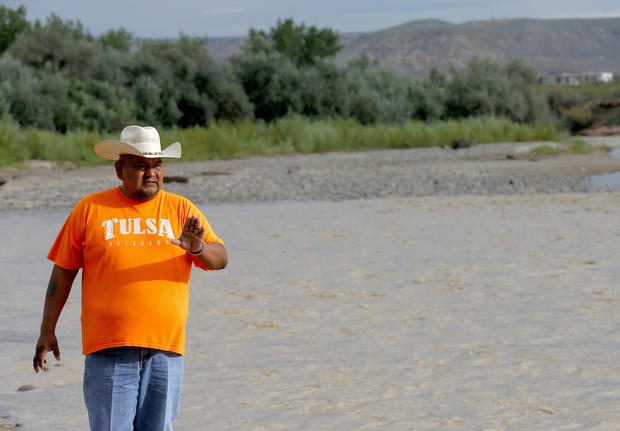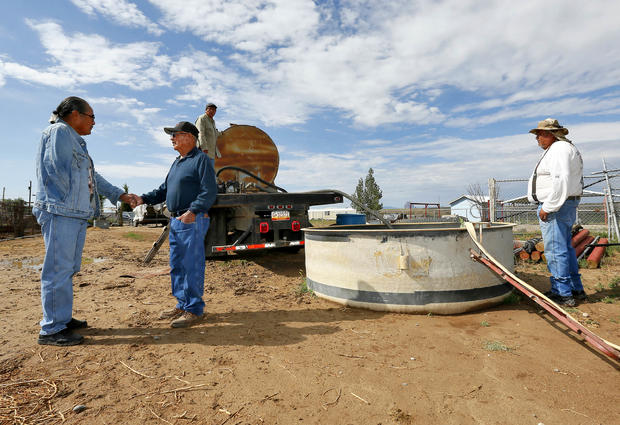EPA: High levels of toxic metal in Animas River water after mine spill
DURANGO, Colo. -- Sampling results from the U.S. Environmental Protection Agency show high levels of toxic heavy metals in the Animas River water following last week's spill at a Colorado mine.
The federal agency released its testing data early Thursday following increasing public pressure.
The test results show water samples taken from the Animas River near Silverton, Colorado, in the hours after the spill contained lead levels more than 200 times the acute exposure limit for aquatic life and more than 3,500 times the limit for human ingestion.
The agency stressed that contamination levels peaked after the spill but have since fallen as the pollution moved downstream and the toxic metals settled to the bottom.
Last week a crew working for the Environmental Protection Agency accidentally breached a dam holding back heavy metals used in gold mining. 3 million gallons of mine waste containing heavy metals was unleashed.
Gov. John Hickenlooper put an iodine tablet in a bottle of Animas River water to kill bacteria before taking a gulp Tuesday. He was trying to prove the river was back to normal.
New Mexico's environment secretary is now criticizing Colorado's governor for drinking water from the contaminated river.
The Farmington Daily Times reports that Secretary Ryan Flynn told residents there Wednesday night that the move was irresponsible and sent a bad message. He said Hickenlooper may as well have lit 15 cigarettes at once.
Hickenlooper, a Democrat, got attention in 2013 after saying he drank a form of fracking fluid to prove it was safe.
Colorado is allowing treatment plants to use river water again, but the Animas remains closed to boating.
Sinjin Eberle of the American Rivers Advocacy Group tells CBS News' Mireya Villarreal that as a result of the spill, dangerous metals like arsenic, zinc and lead have settled into the river bottom and on the banks.
EPA Administrator Gina McCarthy is scheduled to meet with state, local and tribal officials Thursday and address reporters on a trail along the Animas River.
The visit follows her stop upstream in Durango, Colorado, on Wednesday. There, McCarthy said she was heartbroken by the spill and announced that investigation field work would stop at mines nationwide as the agency looks into what led up to last week's disaster.
The Gold King spill was also proving devastating to the Navajo Nation, which recently negotiated a settlement giving it rights to water from the San Juan River. The tribe plans to build a $20 million water treatment plant in northwestern New Mexico to take in the extra volume of water granted by the settlement and provide a clean drinking source to more of the 16,000 families on the reservation who still haul water to their homes.
The plume of heavy metals, including arsenic and lead, flowed into southwest Colorado's Animas River and also into the San Juan River in New Mexico.
Heavy metals already were present in the tribe's underground aquifers, and "now those same things are dumped in the river," complained Rex Kontz, deputy general manager for the Navajo Tribal Utility Authority. He said meeting EPA standards for clean drinking water could double the plant's cost and require millions more in operating costs each year.
The EPA said it will be Monday at least, but perhaps take weeks more, before test results can help show what hazardous materials are in the water. The higher the concentrations, the higher the cost of removing heavy metals. And unlike some other Native American tribes, the Navajo are not swimming in casino cash.
"This new water coming in was the avenue to creating new development and creating long-term sustainability," Kontz said. "Now it's almost like your legs were cut out from under you."
Navajo farmers were nervously waiting for someone to announce that it's OK to irrigate their crops again. Just two weeks without water could wipe out their corn and alfalfa just before harvest, which represents an entire year's salary for some farming families.
The president of the Navajo Nation is advising tribal members not to submit claims for federal reimbursement for the Colorado mine spill.
President Russell Begaye says doing so means Navajos waive any future claim for injuries. Tribal ranchers have had to move their livestock away from the polluted San Juan River, and farmers worry their crops will suffer. Begaye says Navajo elders also might not know what they're signing.
Begaye says the EPA has distributed claim forms at public hearings across the Navajo Reservation and urged tribal members to sign them.
Toxicologists say those people who live along the Animas River could be ingesting the contaminated water in any number of ways, such as drinking it or showering in it.
As CBS News' Mireya Villarreal previously reported, many of the people living along the Animas River receive their water from wells. Some residents along the river rely on it for every day life.
Colorado says it's now safe for Durango to process river water into drinking water.

